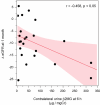The impact of ischemic reperfusion injury on contralateral kidneys and the determinants of renal prognosis after robot-assisted partial nephrectomy
- PMID: 40233076
- PMCID: PMC11999104
- DOI: 10.1371/journal.pone.0321769
The impact of ischemic reperfusion injury on contralateral kidneys and the determinants of renal prognosis after robot-assisted partial nephrectomy
Abstract
Robot-assisted laparoscopic partial nephrectomy (RAPN) is a safe and effective option for renal cell carcinoma (RCC). However, clamping of renal artery during RAPN sometimes causes ischemic reperfusion (IR) injury (IRI), which affects renal function at some later time. In the present study, we inserted catheters into the bilateral ureters from before RAPN until 24 hours after and analyzed urine biomarkers of renal injury excreted from both resected and contralateral kidneys to determine and investigated which biomarkers predict the future decline in renal function in patients with RCC and rodent IR model. Twenty-three patients diagnosed with RCC (66.4 ± 10.8 years old, eGFR: 73.6 ± 15.3 mL/min/1.73m2) were enrolled and ureteral catheters were inserted in both ureters. Urinary neutrophil gelatinase-associated lipocalin (NGAL), beta-2-microglobulin (β₂MG), N-acetyl-β-D-glucosaminidase were measured at several time points. Gene expression of injury markers in contralateral kidneys were analyzed in unilateral IR rodents. All the urinary markers were elevated 30 minutes after the clamping and sustained high until 24 hours in resected kidneys. Meanwhile, urinary NGAL and β2MG excreted from contralateral kidneys increased at 6 and 24 hours after the clamping. Warm ischemic time, estimated blood loss, and excised kidney weight were not associated with renal dysfunction; however, only contralateral urinary β2MG at 6 hours was correlated. Ngal and Il-6 mRNA in contralateral kidneys were upregulated in unilateral IR rodents. RAPN-related IRI induces contralateral kidney injury. Contralateral urinary β2MG can become a potent biomarker to predict the onset of kidney injury after RAPN.
Copyright: © 2025 Matsuo et al. This is an open access article distributed under the terms of the Creative Commons Attribution License, which permits unrestricted use, distribution, and reproduction in any medium, provided the original author and source are credited.
Conflict of interest statement
I have no competing interests regarding this paper.
Figures




Similar articles
-
Dynamics of Urinary Calprotectin after Renal Ischaemia.PLoS One. 2016 Jan 8;11(1):e0146395. doi: 10.1371/journal.pone.0146395. eCollection 2016. PLoS One. 2016. PMID: 26745147 Free PMC article.
-
Urinary cystatin C and NGAL as early biomarkers for assessment of renal ischemia-reperfusion injury: a serum marker to replace creatinine?J Endourol. 2013 Dec;27(12):1510-5. doi: 10.1089/end.2013.0198. Epub 2013 Nov 22. J Endourol. 2013. PMID: 24266750
-
Accuracy of Urinary Neutrophil Gelatinase-Associated Lipocalin in Quantifying Acute Kidney Injury after Partial Nephrectomy in Patients with Normal Contralateral Kidney.PLoS One. 2015 Jul 22;10(7):e0133675. doi: 10.1371/journal.pone.0133675. eCollection 2015. PLoS One. 2015. PMID: 26200468 Free PMC article. Clinical Trial.
-
The variation of selective uNGAL levels after robot-assisted partial nephrectomy: Early results of a prospective single center study.Arch Ital Urol Androl. 2019 Jul 2;91(2). doi: 10.4081/aiua.2019.2.74. Arch Ital Urol Androl. 2019. PMID: 31266271
-
Urinary biomarkers in hydronephrosis.Dan Med J. 2013 Feb;60(2):B4582. Dan Med J. 2013. PMID: 23461995 Review.
References
-
- Van Poppel H, Da Pozzo L, Albrecht W, Matveev V, Bono A, Borkowski A, et al.. A prospective, randomised EORTC intergroup phase 3 study comparing the oncologic outcome of elective nephron-sparing surgery and radical nephrectomy for low-stage renal cell carcinoma. Eur Urol. 2011;59(4):543–52. doi: 10.1016/j.eururo.2010.12.013 - DOI - PubMed
MeSH terms
Substances
LinkOut - more resources
Full Text Sources
Medical
Research Materials
Miscellaneous

